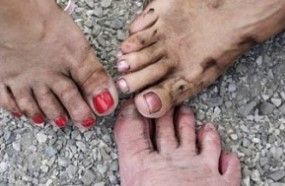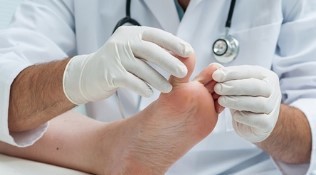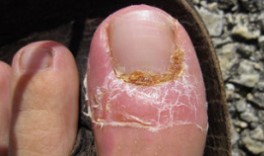Fungus of the nails of the feet (onychomycosis) — one of the most common infectious diseases, with difficulty is easily treatable. According to statistics, every third inhabitant of the planet suffers from fungal infections, which is able not only to affect the skin and nails, but cause the most severe health disorders. In advanced cases, from the waste of pathogenic fungi suffer the internal organs, it becomes reduction of total and local immunity, and often develop complications associated with secondary bacterial infection.

Completely get rid of the mildew it is difficult, the process of treatment is time-consuming, requires careful compliance with medical directives. In addition, if you don't bring the course of treatment until the end, the risk of relapse and further progression of the disease. In the pharmaceutical market today, which is represented by a wide range of anti-fungal, to fight the infection. Not only is ointments, gels, sprays, varnishes, and the system of medicines intended for administration by mouth. To tell you more about the how to cure nail fungus on the feet and what medication according to the doctors-mycologists and dermatologists will allow the most effective response to the problem. But first, stop at the first sign of infection and modes of infection.
Fungus of the nails of the feet — causes of infection
The doctors that produce several main reasons for infection by the fungus:
- Direct contact with the parent of the fungal infection.
- The non-observance of hygiene rules
- Reduced immunity
- Damage interruption due to wearing uncomfortable shoes
- Chronic diseases
Infection by the fungus occurs due to infringement of elementary rules of hygiene or by contact with the parent. For example, you can get infected with the family, if one of the representatives is suffering from onychomycosis. Enough to wear foreign slippers, to take advantage of the common towel or other household items.
Fungal infection can easily get into public places with high temperature and humidity (swimming pool, hammam, sauna, shared bathroom, gym). There is a favorable climate for the growth of pathogenic fungi, and created the conditions for the contact of bare feet with a contaminated surface. Fungi feel great and actively reproduced exactly in a moist and warm environment. Can remain for a long time on all surfaces (benches, carpet coatings, on the floor). If the person in a public place barefoot, spores of fungi within the foot, toes and nails.
Portal of entry for infections serve small nicks, abrasions, calluses, sores on the feet of the feet, which appear as a result of wearing tight and uncomfortable shoes. But even in this case, contamination may not occur, if a person is a good immune system, capable of on their own to cope with the infection. If the immune system is weakened, then the infection can not be avoided. The appearance of fungi often promotes excessive sweating of the feet or of the relevant chronic diseases (diabetes mellitus, psoriasis, varicose veins).

The fungus first attacks the skin stand and the area between the toes, and then spreads to the nail plate, where in the absence of timely treatment, it continues to grow and multiply. The infection develops slowly, so in the early stages to detect the fungus of the nails of the feet difficult. In order to effectively deal with onychomycosis, the treatment should be initiated as early as possible, so that for the first signs of infection you should be aware of each.
The symptoms and picture
The first signs of the fungi in the feet is burning sensation and itching. The skin of the leg, between your fingers begins to peel off, it shows bubbles, which burst, forming cracks and sores. If time does not start treatment, the fungus spreads further and penetrates under the nails, selecting the point of detection area below the fingernail, where there are the nutrients that are necessary for further replication and development.
Secured below the plate of the nail, the fungus starts to produce special enzymes, destroying tissue and the stratum corneum and contributing to the spread thread, the mycelium. In the early stages of infection with external screens almost invisible, therefore, in these few draws in the attention, but as a further development of the begin to appear characteristic symptoms:
- Changes the appearance of the nail. It becomes dull, wearing a yellow or white spots, characteristic of longitudinal or transverse strips. Over time nail whole color-changing and may become fully yellow, gray or even black.
- Around the nail skin on fingers may turn red and get infected. This process is accompanied by itching and pain of inflamed area of the skin.
- The nails are starting to get thicker, crumble, deform and if left untreated, it can peel off with your nail bed.
A description of the damage depends to a large extent by the variety of fungi. So, when infection of dermatophytes, a characteristic symptom is the appearance of yellow spots and longitudinal stripes in the centre and on the edges of the nail. If under the nail hit yeast fungi, then the destructive activity starts on the sides of the nail, which slowly turns yellow and starts lagging behind from the nail bed. If the nail black, then these changes, most likely caused by the fungus of mold.
One of the serious complications avium is ingrown nail. Nail plate, die fungus, over time, thickens, grows right, twists and cuts in the skin. As a result, they grow in the nails indicate about yourself, intense pain when walking, injure the skin and cause the inclusion to a bacterial infection. When you do this, the toe of the blushes and swells, by the bottom of the nail pus. The person with the sick nail is difficult to walk because of the pain. A similar complication is particularly dangerous for patients with diabetes mellitus, as it may cause gangrene defeat ends.
If you don't start the treatment with the first adverse symptoms, the disease will evolve, and the future of the athlete is true for all the nails. In difficult cases, by a fungal infection begins to suffer the whole body: allergic reactions, disorders of the digestive system and other symptoms of poisoning caused by invasion of fungal toxins into the bloodstream and the lymphatic system. When the first alarming symptoms, you should consult with a specialist, which selects the optimal curative treatment and constitutes an effective treatment for nail fungus in the feet.

The treatment of nail fungus
At the first sign of the fungus on the feet you will need to take active measures to deal with, you don't have to hope that the symptoms will disappear by themselves. This will not happen. A fungal infection over time will evolve and may lead to serious health problems. Therefore, the sooner you start treatment, the greater the chance to get rid of onychomycosis and for all. Today in the arsenal of dermatologists and mycologists are extremely medication for nail fungus on the feet of the general and local action.
During the initial stage of the disease, when the extent of the destruction is minimal, it may limit the use of local anti-fungal medications of a wide range of (ointments, creams, solutions, varnishes, spray). If the process has gone too far and the claws completely amazed by the fungus, part of a comprehensive treatment include antifungal systemic action, in tablets. Most of these drugs have serious contraindications and side effects, therefore, grants specialist, and the treatment is carried out under his control. We will stop more for a medicinal product intended for the treatment of fungus.
Solutions, varnishes. At an early stage can be used anti-fungal solutions, and nail polishes. A variety of these tools in great variety.
Ointments, gels, cream.
For the external treatment of nail, of the affected fungus, used groups of medicines on the basis of terbinafine, naftifin, ciclopiroxolamine, ketoconazole.Capsules, tablets.
In complicated forms of fungal infections external treatment is complete the acceptance antifungal medicines in the form of tablets. Without a system of antifungals can't do in these cases, when the disease progresses, and treatment is only local inside ineffective. Drugs for the treatment of fungus too, to get them you have an experienced doctor, as many of them have serious contraindications and restrictions of use. Such tools you can't get children, pregnant women, patients with abnormalities of the liver and kidney. The effectiveness of these instruments is very high, in combination with local medication, it is possible to achieve persistent results and to deal with onychomycosis, avoiding repeated relapses of the disease.Means for removal of nail.
If a claw, surprised in full, before the start of treatment better to delete it. An alternative to the surgical method used especially cosmetics, allowing painlessly remove the nail, smitten by the fungus.The treatment of nail fungus on legs folk remedies
There are many popular recipes that help to stop the spread of the fungus and to deal with him in the early stages. Imagine your attention to a few popular recipes, used for the treatment of nail fungus of the feet at home.
- Tea mushroom. Effective means of mildew is a compress with the use of the discs kombucha. The wrapped in a sterile bandage, apply to the nail and fix an adhesive tape. Is the compress can stay for the night, not the foot wear socks. During the procedure can be felt burning sensation, but the result is worth waiting for. In the morning remove the poultice, softened, granular layer, remove the tool, nail surface is treated with an antiseptic solution.
- Creolin. It's cheap veterinary tool with powerful antiparasitic and disinfection action. To apply you need to be very carefully, avoiding to take for healthy skin, as it can get a burn. To avoid this, a strip of skin around the nail should stick with adhesive tape. The affected nail process Creolin once a day for 2 months until full recovery.
- Comparison of basin. For the treatment of fungus you can do foot baths with apple cider vinegar or lemon juice. The duration of the procedure – is not more than 15 minutes. Good results gives the treatment of the nail solution of propolis, baking soda or epsom salt. The nails can lubricate the tea tree oil, lavender, oregano, have antiseptic and antifungal activity. Many traditional recipes rely on the use of garlic, vinegar, alcohol, onion. Before, how to use similar recipes for yourself, don't forget to consult your doctor.

The prevention of the disease
To avoid contamination by the fungus, follow the simple instructions:
- Don't walk barefoot in a swimming pool,steam room, gym and other public places. In places with high humidity, you need to wear rubber slippers or flip-flops. As measures for the prevention of apply on the nails antifungal nail Polish, it will protect you from infection.
- Never use a foreign shoes, slippers, socks, towels and other household items. All products for personal hygiene and pedicure tools should be strictly individual.
- Wear comfortable shoes, of course, breathable materials. The shoes should not be close, rubbing and injure his leg.
- The feet should be washed twice a day, morning and night and change daily socks and stockings. After water procedures feet wipe to dry, carefully dry the skin between the toes.
- The fungus is particularly active with reduced immunity. Therefore, watch out for their health, timely treatment of concomitant diseases, take κυτοκινινών drugs. Maintain defenses of the body proper and balanced diet, eat more vegetables and fruits, rich in vitamins and minerals.
- During the process of shoes antiseptic solutions, this will help prevent the recurrence of the disease. You can disinfect the shoes, formalin solution, or vinegar, carefully processing inside. After the processing of cotton, moistened with antiseptic solution, should be put on-toe shoes and to place it in an airtight plastic bag the day.
These simple preventive measures will help to protect yourself from mildew and maintain the health of the feet. Remember that the nail fungus on the feet is treated in a very long time and it is difficult, therefore, it is important not to let the appearance of fungal growth, carefully to observe the rules of hygiene and take the time to respond to any adverse effects, which may be the first signs of infection.































